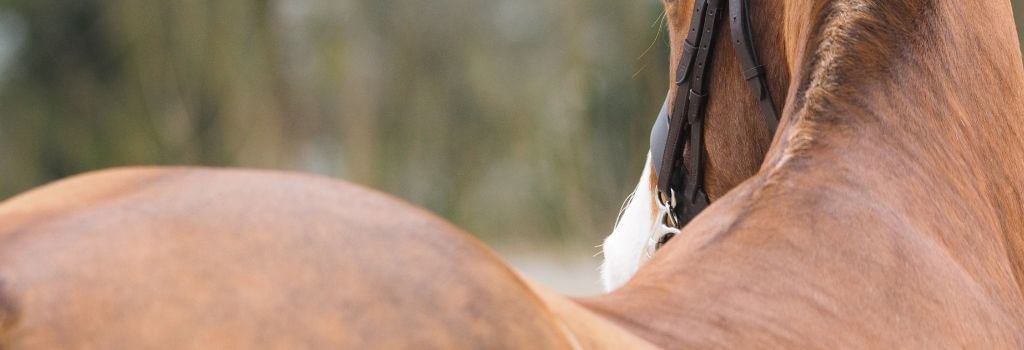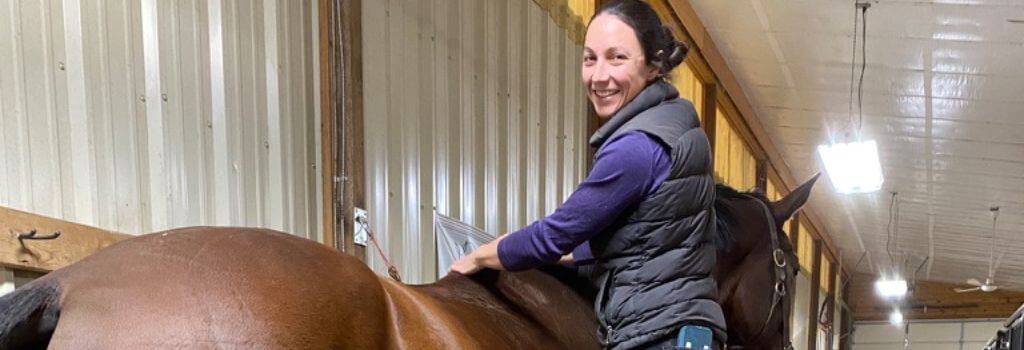Kissing spine, also known as "overriding dorsal spinous processes," is a condition that affects many horses, particularly those involved in sports or regular riding activities. Understanding this condition, its causes, and available management strategies can help horse owners ensure the best care for their equine companions.
What is Kissing Spine and What Causes This Condition?
Kissing spine occurs when the dorsal spinous processes (DSPs) of adjacent vertebrae in the horse's spine become too close together or even touch and overlap. According to the Tufts University Cummings School of Veterinary Medicine, kissing spine may affect up to 40% of horses and can occur due to muscle spasms in the interspinous ligament that can draw DSPs closer together over time; however, research has demonstrated that kissing spine in horses can be influenced by multiple factors such as genetics, poor conformation, repetitive strain, and sometimes improper riding techniques. Chronic muscle tension can exacerbate the issue but is not the sole cause. This condition can lead to pain, inflammation, and further spinal issues, impacting the overall health, well-being, and fitness of a horse.
In healthy horses, DSPs should be evenly spaced, with no touching or overlapping occurring. The anatomy of some horses may lead to uneven spacing of DSPs; however, not to the extent and closeness that occurs in instances of kissing spine.
Kissing spine in horses is often associated with:
- Genetic Predisposition: Some breeds, like Thoroughbreds, Warmbloods, and other performance horses, are more prone to this condition, due to their anatomy, as well as the work they perform. Recent research studies have demonstrated a link between a horse’s genetics and kissing spine susceptibility.
- Poor Saddle Fit: Improperly fitting saddles can cause excessive pressure on the back and unnecessary muscle strain.
- Inconsistent Training: Sudden changes in training intensity or type may contribute to the development of kissing spine as well as other spine-related issues.
- Poor Conditioning or Fitness: A horse that is not fit may be more susceptible to back issues.
Common Signs and Symptoms of Kissing Spine
Some horses with kissing spine may exhibit signs of consistent, low-grade pain or discomfort, while other horses may not exhibit any common clinical signs at all. Because the displayed signs and symptoms of kissing spine can be so variable from horse to horse, it is crucial for horse owners to closely monitor their horses at all times for any indications of discomfort, behavioral changes, or deviations from their typical baseline of health.
Horse owners should watch for the following signs that may indicate kissing spine:
- Unwillingness to work or a change in performance level
- Resistance to being saddled or cinched
- Stiffness in the back, especially when transitioning between gaits
- Abnormal posture or difficulty rounding the back
- Sensitivity to touch along the back
- Behavioral changes, such as bucking or rearing

How is Kissing Spine Diagnosed?
Kissing spine may not always be a straightforward diagnosis due to the variability of clinic signs and the lack of presentation of symptoms in some affected horses. The behavioral changes and displays of discomfort can sometimes be difficult to differentiate from training issues and other unrelated medical conditions that may cause thoracolumbar pain, which is why it is so important for horse owners to work closely with their veterinarian to ensure an accurate diagnosis and appropriate course of treatment.
When working with a veterinarian to diagnose instances of kissing spine in horses, you can expect them to follow similar steps to those we’ve outlined below:
- Veterinary Examination: A thorough physical examination will assess posture and movement.
- Imaging: Diagnostic imaging like X-rays and sometimes ultrasound or nuclear scintigraphy (bone-scan) is often used to confirm the condition. X-rays can reveal changes to the spinous processes and identify any overriding vertebrae.
Survey data of responses from equine orthopaedic specialists reveals that despite regional differences the steps taken to investigate and diagnose equine back pain are largely similar across veterinary professionals. Palpation, physical examination, and imaging are largely preferred for initial investigation into equine back pain and the diagnosis of kissing spine.
Treatment Options for Horses Diagnosed with Kissing Spine
Treatment for kissing spine can vary depending on the severity of each case, as well as the preference of the leading veterinarian.
Treatment for kissing spine may vary but often includes:
- Physical Therapy or Rehabilitation: Massage, stretching, and specific exercises can help improve flexibility and core strength. Certain rehabilitation modalities, such as resistance band systems and water treadmills, can also be helpful when used correctly under the supervision of a certified rehabilitation veterinarian.
- Chiropractic Care: Equine chiropractors may help alleviate pain and improve spinal alignment.
- Injections: In some cases, corticosteroid or hyaluronic acid injections may be administered to reduce inflammation.
- Conservative Management: This may involve rest, anti-inflammatory medications, and pain management.
In more severe cases that do not resolve with the above management strategies, surgical options may be considered. According to Tufts University, “The procedure that is routinely performed for the management of impinging DSPs is an inter-spinous ligament desmotomy (ISLD).”
Can Kissing Spine be Prevented?
While not all cases of kissing spine in horses can be prevented, especially due to generic predisposal, risk factors can be managed for more favorable outcomes. Prevention strategies most commonly focus on maintaining the horse’s overall health, musculoskeletal strength, and proper management practices. Proactive prevention strategies that horse owners can employ include:
- Proper Saddle Fitting: Ensuring that saddles fit well can reduce pressure on the back.
- Regular Conditioning: Implementing a well-rounded fitness regime helps build muscle strength and support the spine.
- Avoiding Abrupt Changes: Gradually increasing training intensity can minimize stress on the back.
- Routine Veterinary and Chiropractic Care: Regular check-ups with a veterinarian can help identify early signs of discomfort or back issues before they progress.
Long-term Effects of Kissing Spine
The long-term effects of kissing spine can vary. Some horses may continue to perform well with proper management, while others may experience chronic pain that could lead to reduced performance capabilities. Addressing the condition early can help mitigate negative outcomes, and help performance and sport horses return to comparable performance levels.
Success of Non-Surgical Treatments and When Surgery is Recommended
Non-surgical treatments can be quite successful, especially when paired with rehabilitation exercises and appropriate management. In a recent survey of veterinarians in the US, 82% reported improvement in clinical signs with rehabilitation alone. Surgery may be recommended if conservative treatments fail to provide relief or if there are significant structural issues that threaten the horse’s long-term mobility.

Recovery Process for Horses Undergoing Treatment
The recovery process largely depends on the treatment method. For surgical cases, horses may need a period of strict stall rest followed by gradual reintroduction to exercise under veterinary guidance. For non-surgical treatments, ongoing management and physical therapy are crucial for recovery.
Role of Exercise and Physical Therapy in Managing Kissing Spine
Both exercise and physical therapy activities are crucial elements of the management of kissing spine in horses, as they strengthen the horse's back, improve flexibility, and reduce pain by supporting proper spinal alignment, and support overall health throughout the rehabilitation process. These interventions are particularly valuable in conservative treatment plans and post-surgery rehabilitation where improving muscle function and facilitating normal movement are important.
Overall, exercise and physical therapy play a significant role in managing kissing spine by:
- Strengthening the back and core muscles to provide better support for the spine.
- Increasing flexibility and reducing stiffness.
- Helping to alleviate pain and improve the horse’s range of motion.
Working with Your Veterinarian
Horse owners should collaborate closely with their veterinarian to develop a comprehensive management plan tailored to their horse's specific needs. This plan may include frequent evaluations, tailored exercise regimens, and nutrition to support recovery and maintain performance.
Finally, understanding kissing spine is vital for horse owners. By being vigilant about signs, seeking timely diagnosis, and implementing effective management strategies, owners can promote their horse's health, performance, and quality of life. Regular veterinary check-ups and open communication with professionals are key to successful outcomes for horses affected by this condition.
If you have questions and you'd like to reach out to us, you can call us directly at (970) 368-3125, or you can email us at [email protected]. Don't forget to follow us on social media Facebook, Instagram.
